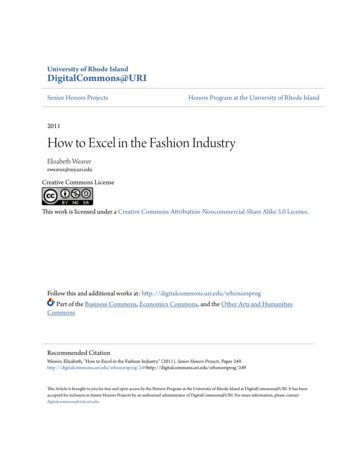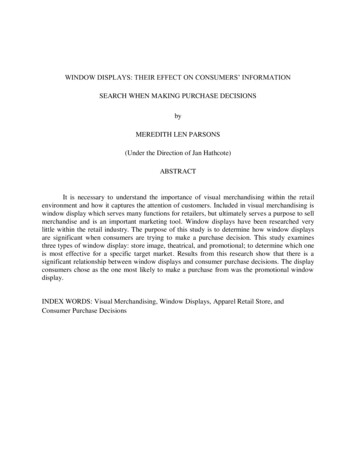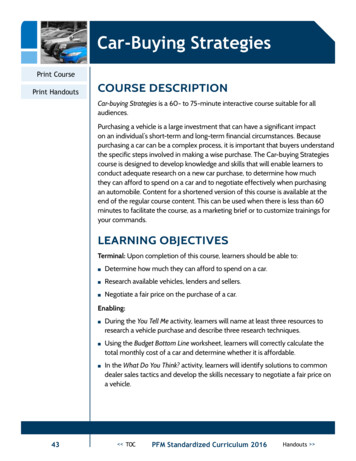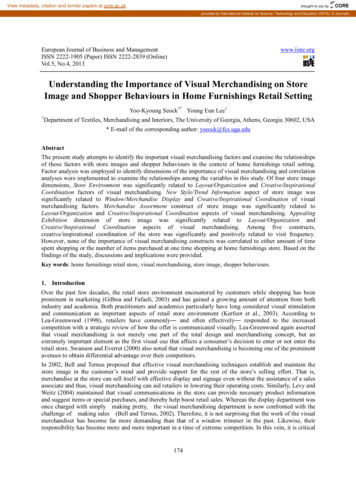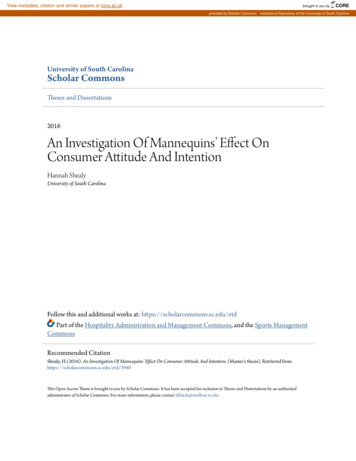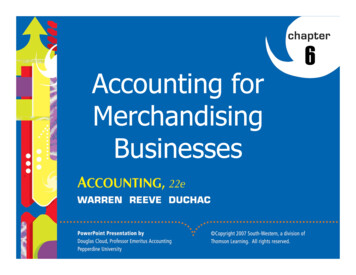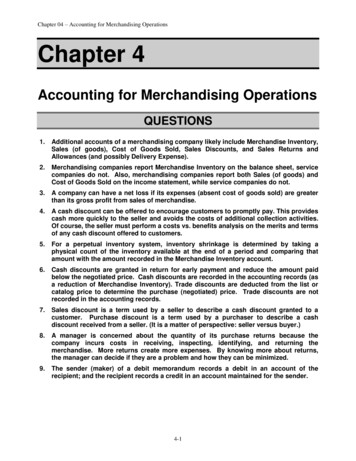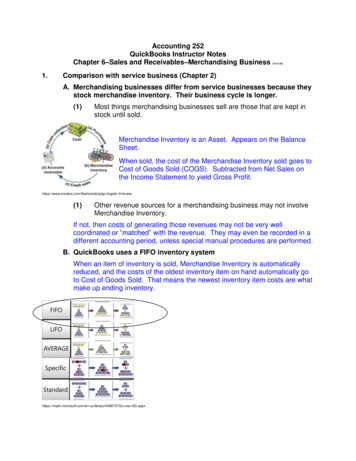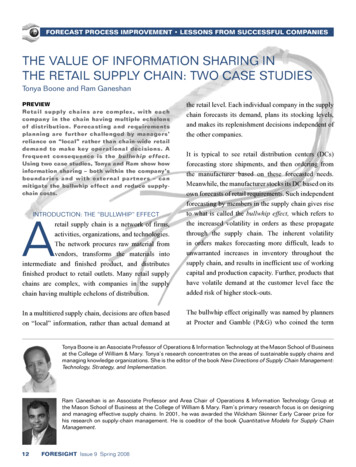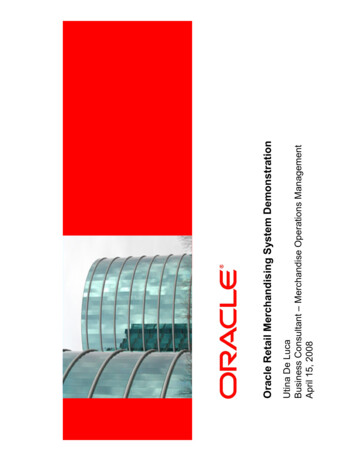
Transcription
Retail Product Merchandising: Retail Buying-Selling CycleSECTION 1: Defining Retail Product MerchandisingPart 1: 1-2 Buying-Selling CycleThe Buying-Selling Cycle is a never ending circle of retail processes and activities that take place in theretail store continually throughout the year. However, these job responsibilities of the retailbuyer/merchandiser are never completed one-at-a-time or on a one-time basis per week, month, oryear. The buyer is constantly multi-tasking and attempting to keep abreast of all factors that impact theday-to-day as well as future operations of the business.The circle of activities begins with planning (i.e., estimating and budgeting sales in dollars and units) andevaluating (i.e., anticipating and forecasting future fashion trends). The job responsibilities in this stepinclude analyzing the dollar and unit sales volume of the previous year, for the same season, for which aseasonal plan is being created, and forecasting the future fashion trends that meet the wants anddemands of the target consumer.The next step of the process is procuring (i.e., searching for, evaluating market offering, selectingproduct classification, and purchasing product) the merchandise mix or product classifications for theseasonal offering. Other continuous steps of the cycle include promoting merchandise (i.e., advertising,special events, publicity, visual merchandising), merchandising the department (i.e., merchandisepresentation, creative display of product), supervising personnel, and managing the store/department.While the cycle of activities for a particular selling season (i.e., spring, summer, early/fall or transition,fall, holiday, cruise/resort) is being completed, those same activities for all of the other selling seasonsare in process in various stages of the cycle. For example, in any given week, a buyer may track sales1
figures during the Fall season and submit reorders for the best-selling items, assist in creating specialevents for the upcoming Holiday/Cruise season, schedule a market trip to procure merchandise for theSpring season and develop and calculate budgets for the upcoming Fall and Holiday seasons.Generally all buyers are responsible for planning and evaluating, procuring, and assisting in promotingmerchandise. However, buyers who are employed by group or corporate offices usually assist, or are notresponsible at all, in merchandising the store/department, supervising personnel, or managing thestore/department. Therefore, this Part of Section 1 will explore in-depth the planning and evaluating,procuring, promoting the merchandise and merchandising the department.In order to have an appropriate background for understanding the in-depth discussion of the BuyingSelling Cycle, an explanation of the organization or formation of the retail year is needed. The retail yearis divided into two six month periods: Spring (i.e., spring and summer sessions) and Fall (i.e., fall/ winter,holiday, and cruise/resort). For each of these major fashion seasons, the buyer develops a merchandiseplan, including a Six-Month Merchandise Budget, product assortment plan, and sales promotional planin order to drive the business of the store/department.The retail year is not based on a calendar year. Rather it begins in February and ends in January of thenext year. Therefore, the Spring season runs from February to July, and the Fall season begins in Augustand ends in January of the next year. Each season is divided into quarters or two three-month periods.The first quarter (i.e., February, March, April) and the second quarter (i.e., May, June, July) are themonths included in the Spring season. The Fall season is divided into the quarters of August throughOctober and November through January.The retail calendar is known as a 4-5-4 calendar. Each season (i.e., Spring, Fall) is composed of 26 weeks.Those weeks are arranged in a 4-week month, 5-week month, and a 4-week month. Therefore, somemonths do not begin or end at the beginning or ending of a regular calendar month. This is, London, or Milan in order to visit designers’ and manufactures’showrooms. There they view the new seasonal lines of designers as well as branded companies.4
Additionally, the buyer may visit regional marts (e.g., Dallas, Atlanta, and Miami) or buildings housingthe showrooms of manufacturing and branded companies in order to select merchandise. Also, someretailers designate space at corporate headquarters so that vendor representatives (i.e., accountexecutives or sales representatives) may come directly to the retail buyer in order to present thecompany’s seasonal lines. Currently, some buyers are previewing vendors’ seasonal lines on the internetin order to view, select, and purchase merchandise.Thus, a buyer has a choice of locations and techniques from which to search for and select merchandise.Frequently buyers utilize several options or different locations and techniques for finalizing the seasonalbuy. The market trip may be organized by a) location, b) key vendors, and/or c) product classifications.More than likely, a buyer will need to select more than one technique for covering the market offering.Shopping the market can be a very productive and satisfying experience or it can be a very demandingand rigorous task. When the buyer locates the “right merchandise”, at the “right price” at the desiredfashion level for the target consumer, shopping the market is very rewarding. However, if the “rightmerchandise” cannot be located during a market trip, the buying task becomes stressful and sometimeseven frustrating.While at market the buyer must take copious notes with regard to vendor offerings. Oftentimes,vendors offer very similar items but at different price points or in different fabrications, colors, or styles.More than likely, the buyer will be required to choose between vendor products with regard to sizes,styles, colors, fabrications and price points. The job has just begun when the buyer departs from themarket!The difficult job in the final stage of procuring the merchandise is selecting the right merchandise, in theright style, color, and size, at the right price, and in the right quantity. Having a well-establishedretail/vendor matrix (i.e., listing of top vendors from which retailer procures product) and establishing a5
seamless working relationship with those vendors make this immense task less difficult and much moresuccessful. The activities in this step will determine the success and profitability of the retailer.Promoting MerchandiseFrequently many buyers play a major role in the marketing of the product, selecting trends and productto feature in advertisements, suggesting special events to promote the goods, and requesting specificvisual presentations in the department or store. All buyers, in some manner or form, will assist inmarketing the product, whether it be acting as a liaison between the store and the vendor in order toprovide an open channel of communications or whether it be assisting with the actual creation of themarketing piece or event.When buyers go to market, they select specific trends and innovative product offerings that should bepromoted. They often make arrangements with the vendor to secure samples for the creation ofadvertisements, other promotional materials, or even gifts-with-purchase (GWP) or purchase-withpurchase (PWP) products. Furthermore, buyers glean ideas in the market for fashion events and/orspecial promotions and events that are most appropriate for marketing a specific brand, trend, or newproduct offering. It behooves the buyer to create as much excitement and entertainment as possible inthe retail store in order to assure that selected merchandise assortments sell. Also, “retailtainment”(i.e., retail entertainment) assures that the store’s target consumers are excited about that particularstore in comparison to the competitors’ stores.Additionally, visual merchandising (i.e., integration of merchandise presentation and display) hasbecome one of the most important factors in building a sound marketing program. Oftentimes buyerswork with vendors in establishing shop concepts or areas within the store solely featuring the vendor’smerchandise mix complete with fixturing, displays, and signage. Also, some buyers assist in creatingplan-o-grams (i.e., sketches or drawings of the placement of merchandise on fixtures positioned on theselling floor, walls, and in displays) which depict the most advantegous placement of merchandise6
categories on the selling floor in order to create optimal sales in the square feet of selling spaceavailable.Merchandising the DepartmentAs previously stated, the buyer may or may not play a role in the merchandising of thestore/department. However, in order to store, house, display, and promote merchandise ormerchandise the department, the buyer oftentimes assists with the planning and execution of themerchandising of the product mix. Whether the buyer only creates a plan-o-gram for arranging productclassifications on the selling floor, or whether the buyer selects a specific product classification to bedisplayed, or whether the buyer suggests new types of fixturing, visual aids for the shop concept, or newlocations for positioning outposts (i.e., freestanding selling unit housing merchandise sold in anotherlocation within the store other than the department in which it is housed), he/she assists inmerchandising the product assortment mix in order to build both customer traffic and additional sales.One of the most effective techniques for presenting the merchandise mix and for creating a productive,yet exciting shopping atmosphere for the consumer, is the 3 x 3 Merchandise Presentation. The 3 x 3Merchandise Presentation is based on relating the store/department design and visual merchandisepresentation to the lifestyle of the consumer. Additionally, it facilitates the ease of selection, makes itconvenient for consumer shopping, and promotes multiple and add-on-sales.The 3 x 3 technique assists the buyer in organizing and presenting all product on the three levels of theline of sight from the customer’s perspective when entering the store/department. The three areas ofthe presentation include: “Windows-on-the-Aisle” (i.e., the entrance and aisle or front one-third of thestore/department), the core or “Bread-and-Butter” area, (i.e., the center or core of thestore/department), and the “Top Walls”, sometimes called “Vista Walls” (i.e., back and side walls ofstore/department).7
In each of the three presentation areas, the customer should find information about the productshoused within, a saleable selection or wide variety of merchandise, and displays that educate or “trainthe fashion eye” of the consumer. This type of merchandising technique should ultimately increase salesvolume and profit margins and hopefully reduce markdowns!The Buying –Selling Cycle is completed with the functions of supervising personnel and managing thedepartment. As previously discussed, unless the buyer is located in a specific retail store, these tworesponsibilities are under the management function of store personnel. However, educating the salesforce in product knowledge, appropriate selling techniques, and store policies and procedures is anecessity for a successful retail operation. Additionally, scheduling employees for efficient and effectivesales floor coverage, maintaining selling supplies, and overseeing the handling of proper customerservice procedures and policies build a loyal customer base and assure return customer visits.In summary, as previously stated, while the cycle of activities for a particular selling season are beingcompleted, those same activities for all of the other selling seasons are simultaneously in process invarious stages of the cycle. Thus, the Buying-Selling Cycle is a never ending circle of retail processes andactivities that continually take place in the retail store throughout the year!In the following Section 2: Establishing the Retail Merchandise Mix, “The Basics of the RetailMerchandise Mix” will be discussed in-depth.8
for correlating fashion trend information into the merchandising process is the Buying-Selling Curve. This curve relates a) the fashion level of the product to its position in the Product Life Cycle, to b) the target consumer, to c) merchandise type, to d) buying techniques, and to e) marketing techniques. (Refer to Section 2: Part 1: 1-4.)
